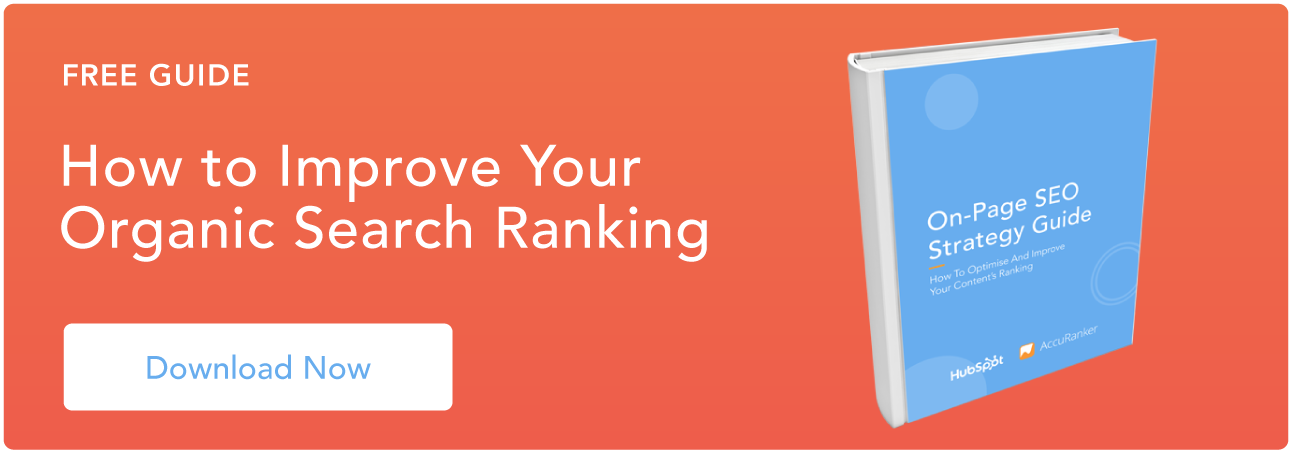“We’re in dire need of some SEO help,” said a owner of a small, successful business located in central Texas. “I can’t put my finger on what’s wrong, but something’s clearly amiss. No one’s reading or sharing the content on our blog, and the information we share on social media just sits there.”

It’s impossible to work in marketing without hearing grievances like this one over and over.
When things go wrong on a website, people often point fingers at technical or on-page SEO. Given the importance of organic search and the role SEO plays in that realm, it's only logical, right?
But too often, the “SEO problem” isn’t SEO at all. It’s content. Dharmesh Shah, HubSpot’s co-founder and CTO, summed up this point nicely in his post on Inbound.org. “The problem most organizations have is not that they're losing some SEO value and traffic that their brilliant content should be generating,” he wrote. “It's that they don't have any/enough brilliant content."
He continued by making an excellent analogy of how many businesses owners obsess over SEO when their time is much better spent focused on content, which is the real meat of their problems. “It's like someone telling me, 'Dharmesh, having an incrementally increasing incline on your treadmill so that you can get your heart-rate up into the optimal zone is much better than just walking on a flat treadmill.' That's technically true, but my issue is not ‘optimizing’ my treadmill usage. My issue is that I need to get off my butt, step away from the computer and just move my body every now and then.”
All the SEO-ing in the world won’t fix bad content for the long haul, which is something that business owner from central Texas learned the hard way.
After doing a site crawl and a content audit of the small business owner’s site, we uncovered the real issue, which was as glaring as it was unsurprising: The brand’s content was poorly targeted, poorly written and contained little in the way of meaningful information.
The business owner was relieved that the money he was spending for SEO help was not going to waste. However, he was confused at where to start in attempting to fix his content and just as perplexed at what the real benefits would be for making the commitment to do so.
Looking For Answers In All The Wrong Places
If you’re serious about inbound marketing, quality content is a must-have, not a nice-to-have. Making the commitment to create and share quality information yields at least five benefits that are hard to beat:
- Attracts the attention of the right prospects
- Ensures prospects continue consuming your information, providing the multiple touch points needed for inbound marketing to work over time
- Helps establish your brand as the definitive resource for information in your area
- Fosters a level of familiarity and trust prospects need to make the leap to become customers
- Enhances the likelihood customers become brand advocates, sharing your information with others
How to Craft Brilliant Content
If you’re serious about creating content that converts prospects to customers and customers to brand advocates, there are three things you need to work on immediately.
1. Know your business.
The better you understand your business and the role it plays in the lives of those you wish to serve, the more equipped you’ll be to market your products and services.
Commit to getting your core marketing team in a room at least once a week for a one-hour brainstorming session. The purpose of the meeting is to gain clarity on three all-important points:
- Who are we?
- What are our goals?
- Who are we in the minds of our core prospects and customers?
The object is to make certain everyone knows — viscerally — what the brand stands for, what role its products/services play in the marketplace, how they are viewed by customers, prospects and competitors, and what the brand offers that no one else could easily replicate.
While answering these questions, keep the business’s marketing and overall goals top of mind, sharing them with everyone in the room and use the goals as guideposts for every action the team undertakes. Have a team member keep notes, which could be stored and shared with everyone via Google Docs.
2. Know your customers.
Most inbound marketers think the toughest part of inbound marketing is knowing what it is their customers want. In reality, knowing what your customers want and expect from your brand is the biggest hurdle, but it’s not an insurmountable task.
Start by looking at the questions and comments your customer service, sales and social media teams field online, via phone or in person. Then look at ways your business is uniquely qualified to be a solution for those problems. What can you provide that no one else can? That’s your sweet spot.
Pay close attention to where most of comments are coming from, especially on social media. This helps discern where the bulk of your audience resides. Most importantly, it highlights where the most active engagers are in the market you serve.
Also, look closely at the sharers of the information: Do they have large social following? Do they share lots of content on the topic? Are their blogs popular? Are links shared as part of their content? Would they be considered influencers? Vigilance in this way yields invaluable insight into where to look for other such engagers, in addition to what types of information they are receptive to and share. (This type of learning provides the basis for developing buyer personas.)
3. Think beyond production.
At this point, you might be wondering what any of this has to do with quality content or SEO. The answer is: everything. One of the best, most useful guides for creating quality content is to become the most definitive answer for the questions prospects and customers have around the products and services you offer.
By answering these questions on your blog and web pages and then sharing and engaging around the content via social media, you’re giving your content the air it needs to breathe. The result?
- You enhance the potential for onsite activity;
- You increase the likelihood for your brand and its content to show up in organic search;
- You generate the requisite social activity that leads to social signals, which could result in inbound links (which are a really important factor that search engines consider when they determine which sites show up on the first page of search results.)
Giving this plan legs is far easier than most assume. First, use the information gleaned during the brainstorming sessions to keep your business/marketing goals in line with the content you produce and share with the audience. Then, access the comments, questions and other information gleaned from your sales, customer service and social media teams to begin creating informative blogs and bite-sized social media nuggets aimed at addressing these issues.
Begin with one or two blogs a week. Instead of worrying about length, think in terms of being the best answer and including compelling graphics, which increases the likelihood of sharing and engagement. Once the content is posted on the site, be sure to share it on at least two social media sites as well, where you can then listen out for additional questions and comments, or thank those who share the information. You can use any new information you learn to better inform future content.
Beware, however, that you’re far from done after creating and sharing your content. You’ll need to continue sharing your content, even as you create more of it.
Additionally, it's necessary to make a concerted effort to engage with influencers who can move the needle for your brand via social media.
Your content needs to work for you, but first you must work for it. Inbound marketing is a circuitous journey, not a straight line. You’ll need to create, share, test, iterate, and repeat many times to find the success you hope for. But as you commit to this hard work, great things start to happen:
- The team’s understanding of the audience’s needs will improve
- Content quality on the website will get better
- Onsite engagement, including comments, will increase
- Social signals will enlarge for the brand
- Links to the website will grow
- Brand content will begin to show up higher in organic search
- Overall website traffic and activity will swell, including among product and services pages
Give Your Brand The Best Chance Of Success
One of the best things you can do for your website’s SEO performance is to make strong, resonant content the hallmark of your brand. The better your content, the easier it is to share and generate engagement around the information — and the brand. And as the brand gets better at iterating, social activity and links are a likely byproduct.
Remember, the most impressive brands are using search, social and content together, not in isolation. Isn’t it time your business followed suit?








![How to Optimize Your URLs for Search [Quick Tip]](https://blog.hubspot.com/hubfs/optimize-url-slugs.jpg)
![The Anatomy of a Search-Friendly URL [Infographic]](https://blog.hubspot.com/hubfs/search-friendly-url-structure.jpeg)
![Want to Rank Better in Search? Avoid These 10 SEO Mistakes [Infographic]](https://blog.hubspot.com/hubfs/00-Blog_Thinkstock_Images/SEO_Mistakes_Infographic.jpeg)
![How to Easily Track Your On-Page SEO Strategy [Free Excel Template]](https://blog.hubspot.com/hubfs/00-Blog-Related_Images/seo-template-blog.png)